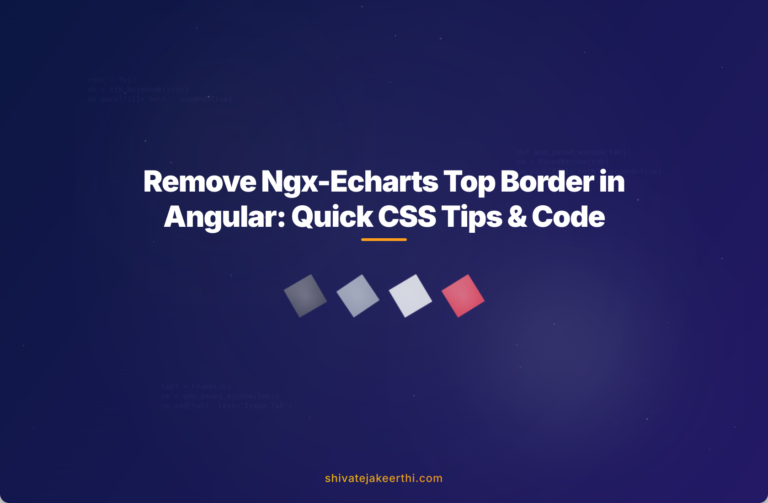When building charts for data visualization, the details make all the difference. One common issue developers encounter using ngx-echarts (a popular Angular wrapper for Apache ECharts) is the prominent top border line appearing in the chart grid. Sometimes, this line is visually distracting and doesn’t align with the overall design.
In this article, we’ll explore practical solutions to hide or remove this top border line in chart grids. We’ll also briefly discuss alternatives and provide actionable tips and code examples to streamline your ngx-echarts customizations.
Understanding ngx-echarts and Its Grid
Before we dive into customization, it’s important to understand the basics. ngx-echarts is an Angular library built upon the powerful and versatile Apache ECharts, enabling easy integration of interactive charts within Angular applications.
One core component of an ECharts visualization is the chart grid—the container holding the axes, axis labels, grid lines, and plotted data. Grids in ngx-echarts provide various configuration options, including properties like left, right, top, and bottom, which set grid margins and padding.
Proper usage of grids ensures readability and organized layouts. Often, grid lines help guide viewers’ eyes, improving accuracy in data interpretation. However, too many grid lines or improper spacing arrangements can reduce visual clarity.
Your chart configuration might look similar to this:
grid: {
left: '10%',
right: '10%',
top: '15%',
bottom: '10%',
containLabel: true,
borderColor: '#ccc'
}
Here, borderColor defines the grid’s outer border line color. By default, this will display borders on all four sides, including the top border—a line users often desire to hide.
Can You Hide Specific Grid Lines in ngx-echarts?
Unfortunately, ngx-echarts and underlying Apache ECharts do not directly support hiding only one specific side of the grid border using configuration properties. Typically, the grid’s border settings apply uniformly on all sides.
So how do we specifically hide the top border line without affecting the rest?
One straightforward method is utilizing CSS styles. Another involves clever adjustments to your chart configuration.
Practical Methods for Hiding the Top Grid Border Line
There are two common approaches developers use to hide or remove this unwanted border:
- Overlay CSS styles: Cover up the top grid line by utilizing CSS overlays.
- Adjust Grid Margins: Position the chart in a way that naturally hides the top border.
Let’s examine these methods in detail.
1. Overlay CSS to Hide Grid Lines in ngx-echarts
Applying CSS is the simplest and most immediate fix, especially suitable for scenarios where quick visual modifications are required without altering extensive logic.
Here’s how it works:
- Place your ngx-echarts canvas inside a parent DIV container.
- Create another empty DIV (overlay) absolutely positioned to cover only the top of your chart grid.
For example, your Angular component’s HTML template would look like this:
<div style="position: relative; width: 100%; height: 400px;">
<div id="top-overlay"></div>
<ngx-echarts [options]="chartOption" style="width: 100%; height: 100%;"></ngx-echarts>
</div>
Then, add the relevant styles in your component’s CSS file or global stylesheet:
#top-overlay {
position: absolute;
top: 0;
left: 10%;
width: 80%;
height: 1px;
background-color: white; /* match the parent background color */
z-index: 10;
}
The left and width values (in percentage or pixels) must exactly match your grid configuration. Otherwise, the white overlay line won’t precisely cover the top border. This solution easily adapts to responsive layouts too—consider using flexible units like percentage or vw/vh to ensure responsiveness.
2. Adjusting Grid Configuration
Another subtle solution involves tweaking your grid settings. By increasing the top margin intentionally, the top grid line becomes obscured or pushed outside the visible region.
Modify your ngx-echarts configurations:
grid: {
left: '10%',
right: '10%',
top: 0, // adjusted here
bottom: '10%',
containLabel: true,
borderColor: '#ccc'
},
xAxis: {
axisLine: {show: false} // hide x-axis if needed
},
yAxis: {
axisLine: {show: false} // hide y-axis if needed
}
Setting top: 0 and disabling axisLine can minimize or hide related lines effectively. Experimentation may be required to perfect this option based on specific chart dimensions and contents.
Don’t hesitate testing (JavaScript debugging tips) different values and configurations until your visual aesthetic is achieved.
Considering Alternative Charting Solutions
While ngx-echarts and ECharts offer unmatched versatility, it’s worth mentioning some alternatives occasionally used by developers that might better fit your specific visualization goals.
Popular charting libraries include:
- Chart.js: Lightweight, simple, widely adaptable.
- D3.js: Highly customizable, SVG-based, steep learning curve.
- ApexCharts: Interactive, modern look-and-feel, versatile themes.
- Highcharts: Premium, highly customizable, responsive.
Here’s a quick comparison:
| Library | Ease of Use | Customization | License |
| ngx-echarts | Medium | High | Apache License 2.0 (Free) |
| Chart.js | Easy | Medium | MIT (Free) |
| D3.js | Difficult | Very High | BSD (Free) |
| ApexCharts | Easy | Medium-High | MIT (Free) |
| Highcharts | Easy-Medium | High | Commercial (Paid) |
Migrating from ngx-echarts involves rewriting chart logic, updating bindings, and potentially adapting data structures. Consider your project requirements carefully before transitioning.
Recap and Next Steps
In this article, we tackled a common visualization issue encountered by ngx-echarts users—hiding the distracting top grid border line. We explored a detailed CSS overlay workaround and configuration adjustments to achieve sleek, modern charts.
We also briefly compared popular alternatives like Chart.js and ApexCharts to help you assess other viable approaches to interactive charting.
Curious about exploring other hidden customization techniques or encountering challenges on anything related? Share your experiences—or ask questions about ngx-echarts customization and alternatives—on platforms like Stack Overflow or in comments here.
Happy charting!



0 Comments